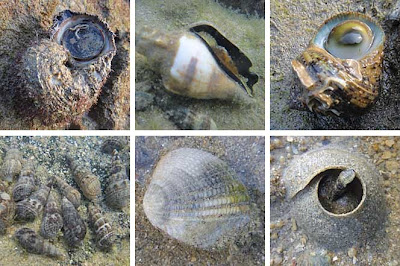Chay Hoon told me she had seen this slug too on our earlier trip with Project Driftnet. It's nice to know that slugs have started coming back to the shore!
A sheen of oil still forms on some parts of the lagoon: here's some collecting around the hard corals growing on the rocks. It still smells like an oil spill on some parts of the shore.
But the hard corals mostly looked alright. I saw one small hard coral that might be a young Circular mushroom corals (Family Fungiidae). There were also many Pore corals (Porites sp.). The most common hard coral on this shore were Favid corals (Family Faviidae) and Zebra corals (Oulastrea crispata) remain quite common on the seawalls.
 |
| Mushroom coral? (top left), Pore corals (top row) Zebra coral (bottom left), Favid corals (bottom row). |
I saw several large colonies of Button zoanthids (Zoanthus sp.) and one large Frilly sea anemone (Phymanthus sp.).
 |
| Button zoanthids (two photos on the left), Frilly anemone (right most). |
 |
| The female shrimp is larger with more obvious white spots. |
I saw two large squids slowly 'flying' through the water! There were lots of fishes with many schools of small fishes, and even one Brown-spotted moray eel (Gymnothorax reevesii) but sneaky camera couldn't photograph them. I thought I saw signs of an octopus too! Spout of water coming out of a hole. Fortunately, today I didn't see a single Hollow-cheeked stonefish (Synanceia horrida). But alas, I didn't see any seahorses either. I didn't see many crabs today, mostly very tiny Flower crabs (Portunus pelagicus).I saw about 10 Common sea stars (Archaster typicus) of a good size, seemed unharmed without any injured body parts. There was even a pair in 'mating' position!
 |
| A male sea star on top of a larger female one. |
It was great to see some of my favourite snails. This included one Dolphin shell snail (Angaria delphinus), many more Black-lipped conch (Strombus urceus) than I had seen before, some big fat Dwarf turban snails (Turbo bruneus). The shore is still teeming with Bazillion snails (Batillaria zonalis) and there are still large numbers of Dubious nerites (Clithon oualaniensis). I saw some ribbed venus clams on the sandy area and some sand collars made by Moon snails though I didn't see any moon snails.
I saw this strange snail that I've not seen alive before. It wasn't very lively though.
And this pretty snail on the rocks. I don't know what it is.
I saw this Firebrand murex (Chicoreus torrefactus) on the sandy area. It had a Bazillion snail (Batillaria zonalis) firmly stuck in the shell opening. Was it eating the smaller snail? Hmmm.
I also saw four large living Fan clams (Family Pinnidae).
I saw the thick large tubes of several Solitary tubeworms (Diopatra sp.), decorated with fallen leaves and shells as usual. There were also several piles of poo of living Acorn worms (Class Enteropneusta). There were also many living fan worms (Family Sabellidae), about the usual number we might see before the oil spill. They all seemed normal.
There's still plenty of oil sheen and scum on the patches of Smooth ribbon seagrass (Cymodocea rotundata). Despite this, the seagrasses seemed alright although the one closer to the Terminal seems to be getting buried in sand. Among the seagrasses, lots of small Haddon's carpet anemones (Stichodactyla haddoni) have settled down! I saw about ten of them in the bigger seagrass patch and one in the smaller patch.
 |
| Small carpet anemones with oil sheen on the seagrasses. |
In the patch of Tape seagrass in deeper water, a filefish (Family Monacanthidae) was quietly pretending to be a plant. In the background, the remains of a female Tape seagrass flower.
I found the patch of Sickle seagrass (Thalassia hemprichii) that I have missed seeing during the last few trips! The patch seems to be about the same size and doing alright.
Here's a closer look at the Sickle seagrasses. Many of the blades were yellowish with dark patches, but they seemed well formed and sturdy. But I still didn't see any Spoon seagrass (Halophila ovalis) here.
The most abundant seaweed remains Mermaid's fan (Padina sp.), with a few clumps of short strands of Sargassum seaweed (Sargassum sp.). On the abandoned ropes, there are lush growths of Pom-pom red seaweed and Codium green seaweed (Codium sp.). The seaweeds were full of tiny Tidal hermit crabs (Diogenes sp.) and on the sandy shores were a few small Striped hermit crabs (Clibanarius sp.).
It was a pleasant, rain-free and relatively sandfly-free day on Tanah Merah, with a lovely sunset.
Let's hope this shore recovers soon!
More about the oil spill on this blog and on the Oil spill facebook page.


















